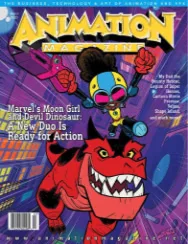
For those privileged enough to engage with the experience, parenthood exists as the ultimate portal for reconnecting with one’s inner child. The energetic duo behind Netflix’s new series My Dad the Bounty Hunter, found different access points to their youth through the show’s creation and development. For Patrick Harpin, the series’ “blue-collar” approach to science fiction allowed him to revisit childhood memories of his parents, while Everett Downing Jr. used the show to speak directly to his kids. “We were really inspired by our family members,” says Downing Jr. “[The family dynamic] is coming from a place of inspiration.”

My Dad the Bounty Hunter follows the intergalactic adventures of Terry, voiced by Laz Alonso, and his two children, Lisa (Priah Ferguson) and Sean (JeCobi Swain). Due to the inherent danger of his vocation, Terry conceals the true nature of his employment and unintentionally creates an emotional chasm between his children and estranged wife. During a weekend trip to their father’s house, Lisa and Sean stow away in Terry’s car/starship and discover an entire universe of terrors and thrills that only their dad can help them navigate.
Running parallel to the realistic depictions of a fractured yet loving family, Harpin and Downing Jr. wanted the show’s technology to possess a functional yet weathered aesthetic reminiscent of their mutual love of science fiction classics like Alien and The Last Starfighter. “There’s a tendency in sci-fi to make everything look shiny and fancy,” says Harpin, who has worked as a story artist on TV shows such as Gravity Falls and features such as Hotel Transylvania 3: Summer Vacation, Smurfs: The Lost Village and Ice Age: Continental Drift.
“I’m constantly seeing beautiful designs and going, ‘I have to make it worn. I have to put duct tape on it.’”
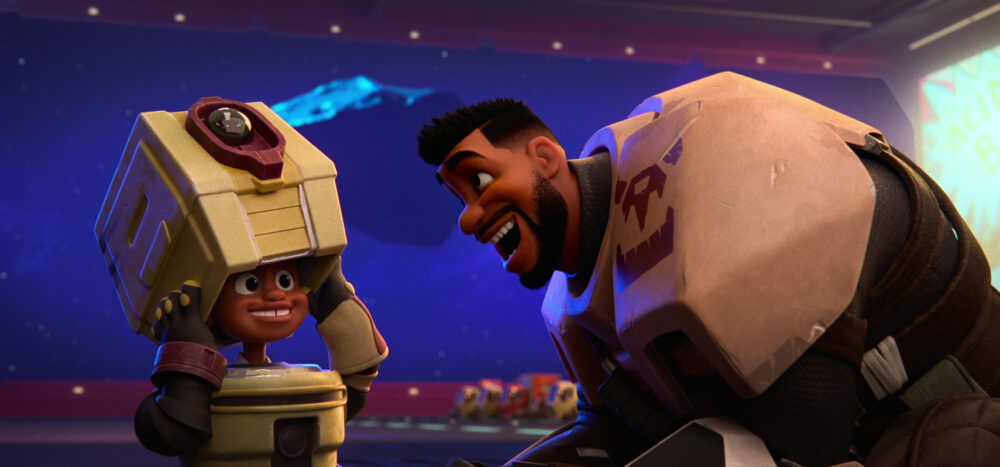
Down-to-Earth Designs
The adherence to the design philosophy also appears in the series’ more terrestrial moments. “Even in the house on Earth, there’s stuff where we were like, ‘can we get, like, fake vinyl floor at the entrance?’” jokes Harpin. “Let’s make it lived in. Like, look at your parent’s house.”
Harpin and Downing Jr’s attention to detail extends beyond the show’s technology and into the intricacies of the lead character’s complexions. In a bold commitment to nuance and realism, the predominately Black cast of My Dad the Bounty Hunter is comprised of various shades of melanin. Despite mild technical and studio difficulties, the duo insisted on making the character Tess — Terry’s estranged wife, played by Yvonne Orji — resemble the pigmentation of her voice actor.

“A lot of people have this mentality that they always want to sort of lighten it,” he says. “So, we had to push back like, ‘Hey, I know you guys are used to doing it, but no, it’s not a mistake. She is supposed to be that dark.’”
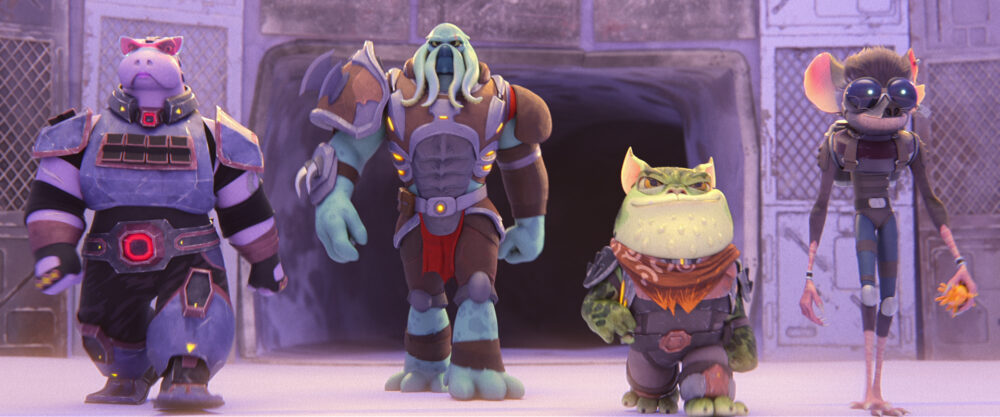
Similar to Tess’s character design, Harpin and Downing Jr. sought to use the show’s narrative to destigmatize an overlooked physical condition through Terry’s son. “[Sean’s facial] twitch is coming from my personal experience with my daughter,” states Downing Jr. “I wanted to show her a different type of bravery. It’s okay if you have a twitch, you can still build that confidence.”
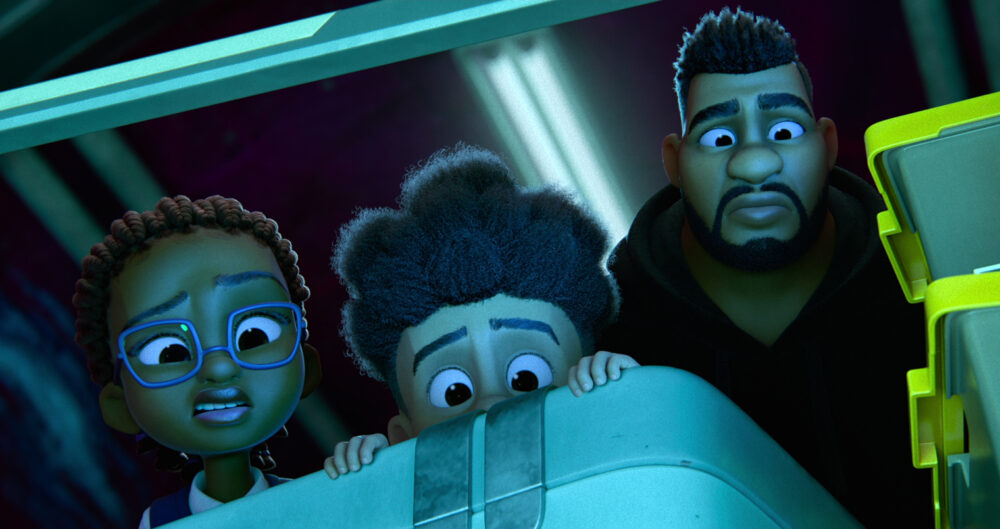
Through a Child’s Eyes
Crafting a show with Downing Jr.’s daughter in mind, the pair aimed to construct a series that didn’t condescend to its younger fans on either a visual or narrative front. “[Kids] go to see real movies,” says Harpin. “I saw Jurassic Park when I was five … [kids are] more literate than we think they are.”
By anticipating a savvy audience, Downing Jr. and Harpin decided to double down on the show’s cinematic approach to storytelling. “Sometimes you ask stuff like, ‘what would Vince Gilligan [creator of Breaking Bad] do with this moment?” says Harpin. “We can really go there in the way [a shot] is composed.”
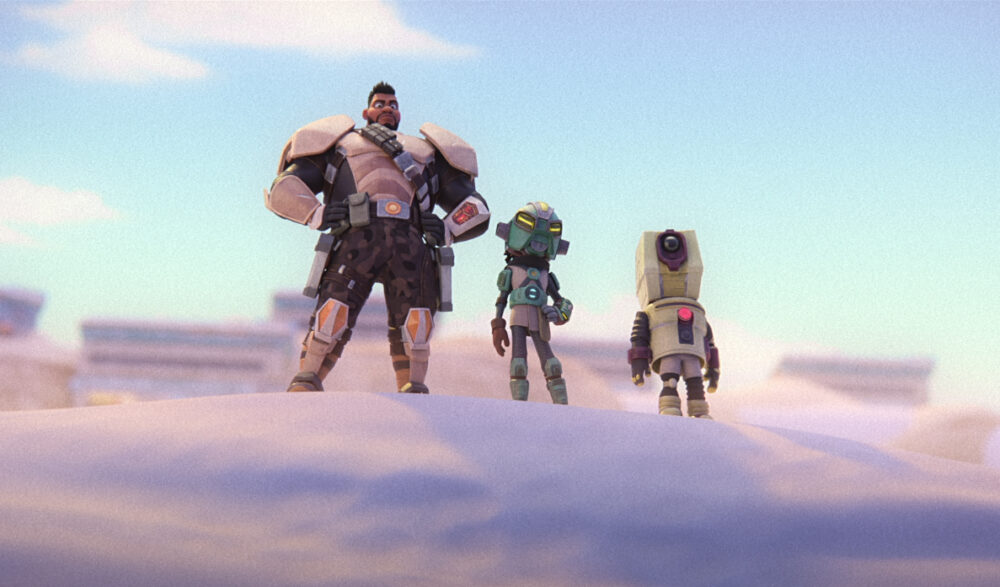
Instead of encountering apprehension from their team, the duo discovered that the show’s intentionally cinematic style helped liberate the creativity of their storyboard artist and the animators at Dwarf Studio, the French company (who has worked on shows such as Trash Truck, Monsters at Work, Pirata & Capitano). “A lot of times, it’s just like freeing yourself to pull from the movies you go see as an adult and use that visual vocabulary,” says Harpin. “What’s an interesting way to do this without dialogue? Sometimes animation can be so talky, and we were like, let’s pull back.”
“Once we told them, ‘Hey, this is what we’re looking for, this is our style guide,’ we were kind of shocked by how they were able to dive into that,” recalls Downing Jr. “Our crew wants to do that stuff. So, when we said, ‘go hog-wild, that’s what we want to do,’ they were excited to jump on that challenge.”
With their shared background as storyboard artists, Harpin and Downing Jr. encouraged their team through a shared enthusiasm for the craft. “[We would say] let’s do slow-mo for this moment like they do in Boogie Nights,” explains Harpin. “That was how we all talked. ‘We’re film heads, and you guys love film, so let’s geek out on that.’ Hopefully, the show feels like that.”
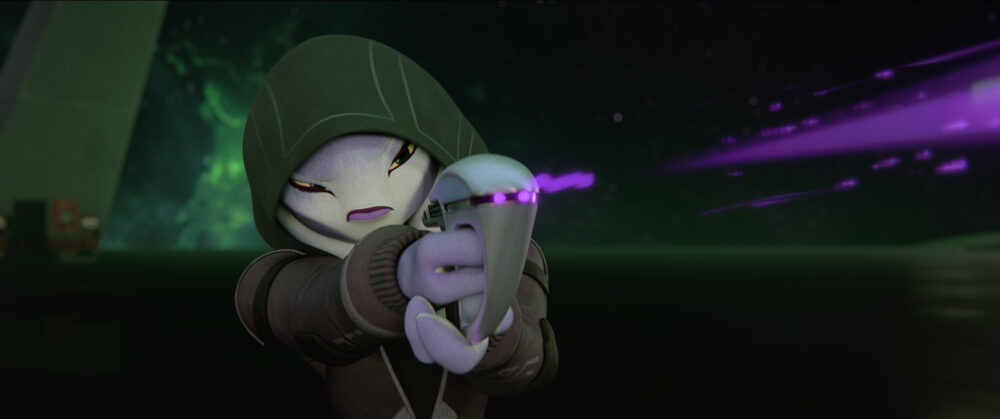
Great Minds Think Alike
When selecting their writers, the duo prioritized recruiting talent who shared their experience as artists. “Our room was kind of led by ex-storyboard artists who write,” says Harpin. “We’ve been board artists, so when you say, ‘And there’s a battle scene with 1000 people,’ [we know] someone is going to have to draw that.”
“Doing a room like that where storyboard people were involved and vocal … it helped everybody,” Harpin continues. “Because people who are not storyboard artists were like, ‘Oh, yeah, that’s true. Maybe we won’t write an army of 5000.’”
In addition to employing industry-standard tools like Maya and Storyboard Pro, Harpin and Downing Jr. discovered unique opportunities for tech to strengthen their team during quarantine and beyond. “I think the biggest thing we used that was super key for us was Blender,” says Downing Jr. “Because our vis-dev department fully embraced it, people were doing low poly presentations for locations and ship designs even before they started drawing, which gave us a good idea for scale.”

Even with the stress of their show’s impending launch, and a second season already in development, both Harpin and Downing Jr. still exude the carefree glee of My Dad the Bounty Hunter’s precocious kid protagonists. “The hardest part is actually convincing people,” says Downing Jr. with a smile. “[People would say] ‘is this too much? Are you going too far?’ And we’re like, ‘No, no, this is going to be great. You’ve got to trust us.’”
My Dad the Bounty Hunter premieres on Netflix on Thursday, February 9. The first full episode is available to watch on the Netflix After School YouTube channel.





![My_Dad_the_Bounty_Hunter_S1_E9_00_21_47_00 My Dad the Bounty Hunter [c/o Netflix]](https://www.animationmagazine.net/wordpress/wp-content/uploads/My_Dad_the_Bounty_Hunter_S1_E9_00_21_47_00-696x418.jpg)
